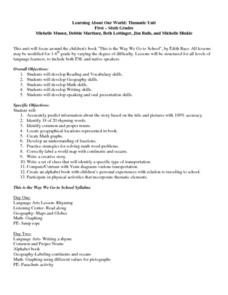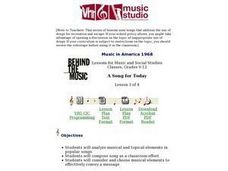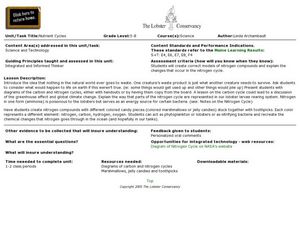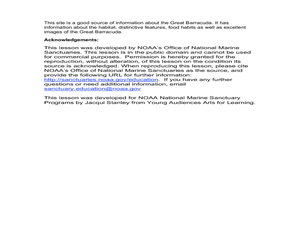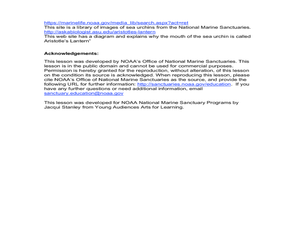American Museum of Natural History
Crazy Camouflage
Scholars discover the crazy camouflage technique of the flounder fish. After reading three informative paragraphs, participants follow steps to make a model of the sea creature.
NOAA
The Dead Zone
The fifth installment of a 23-part NOAA Enrichment in Marine sciences and Oceanography (NEMO) program defines dead zones and how they form. Pupils then examine data from the Gulf of Mexico to determine dead zone formation.
Curated OER
Friendship Mobiles
Students discuss how the sun, wind, clouds and other elements of nature can be their friends. They create mobile demonstrating this.
Curated OER
Ocean Water
In this ocean water worksheet, students use 6 given terms related to ocean water, early Earth and ocean components to complete the sentences. They also answer 4 questions about seawater, the effects of volcanoes on oceans and ocean life.
Curated OER
Dig Into Ireland
High schoolers explore environments and wildlife of Ireland to find out how they were formed, and how they helped form Irish culture. Students research online to determine connections between present elements in Irish culture and...
Curated OER
Plate Tectonics
Students research separate elements of the theory of Plate Tectonics, then share that information with each other, drawing conclusions from the culminated information.
Curated OER
The Gifts of the Nile
Get your class thinking about the geography that shaped the Egyptian landscape and culture. They compare ancient climate zones and geogrpahical fetures, locate evidence of plate tectonics, take and quiz, and write a short essay. The...
Curated OER
Rhythmic Movement
Explore how waves move in the ocean with your young learners. Fill a two-liter bottle half full with colored water, and have the youngsters move the bottle to make waves inside of it. Then have them listen to the song "Wipe Out"....
Curated OER
Pirates of the Caribbean: Dead Man's Chest Activity Worksheet and Progress Test
In this Pirates of the Caribbean: Dead Man's Chest activity and progress test worksheet, students respond to a total of 17 short answer, multiple choice, matching, and fill in the blank questions pertaining to Pirates of the Caribbean:...
Curated OER
Science: Not just Gold
Young scholars articulate a possible relationship between arsenic and gold deposits in a written statement using data to substantiate the relationship they describe. They use real data to determine the source of the arsenic in the...
Curated OER
All That Glitters...
Students study that white light (visible light) is comprised of all colors of the spectrum. They study that the quantity of light decreases with increasing depth in the ocean. They study that the quality of light changes with increasing...
Curated OER
Ocean Water
For this ocean water worksheet, students will look at how oceans affect us, how oceans originated, and what oceans are made up of. This worksheet has 15 fill in the blank questions.
Curated OER
Biocomplexity Lab Activity: Creating Salt Water
The lesson seeks to intorduce to young scholars the properties of salt water and how to create salt water. Teacher gives backgound information about salt water to students. From that point, young scholars dscuss what elements are in...
Curated OER
Learning About Our World
Young scholars explore their world using the book "This is the Way We Go to School." They predict information about the story based on the title and pictures. Students label a world map with the names of continents and oceans. They write...
Curated OER
A Song for Today - Lesson 3
Students analyze musical and topical elements in popular songs and compose song as a classroom effort. They write a short paragraph evaluating the effectiveness of the song in conveying the message of the lyrics.
Curated OER
Water, Water Everywhere
Students study the location of Earth's water and study the water cycle using a terrarium. In this water study lesson, students study a model globe for the Earth and find Alaska. Students locate the bodies of water and study an overhead...
Curated OER
The Nutrient Cycles
Students investigate the circle of sea life by creating nitrogen compound models. In this oceanography lesson, students discuss sea creatures and where their waste goes. Students identify nitrogen cycles in the ocean by...
Curated OER
The Great Barracuda
Students explore oceanography by researching the great barracuda. In this animal life lesson, students read several vocabulary terms dealing with ocean life and examine a drawing of a barracuda. Students examine the many...
Curated OER
Swimming with Crabs
Students explore Earth science by completing several graphic organizer activities in class. In this oceanography lesson, students research ocean inhabitants such as blue crab and oysters. Students complete graphic organizers about the...
Curated OER
Estuarine Currents
Pupils explore an estuarine system to gather data on density driven currents. This type of current is contrasted with temperature and wind driven currents.
Curated OER
The Inside Current
Eighth graders explore ocean currents and wind patterns. They discover the concept of systems to show how change in one component of a body of water, causes change in other components in that system. Students describe positive and...
Curated OER
The Economics of Conflict
Seventh graders examine how economics can empower or disempowers people of a nation. In groups, they analyze how commodities for economic power have changed and the trends that might affect future empowerment. They describe Canada's...
Curated OER
Sea Urchins - Diadema Antillarum
Pupils investigate oceanography by painting sea life. In this crustacean lesson, students identify sea urchins in our ocean environments and describe the functionality of their spherical-shaped bodies. Pupils design their own sea urchins...
Curated OER
Breaking it Down
High schoolers will identify the factors that contribute to erosion and weathering. They will start by differentiating between chemical and mechanical weathering. They then apply what they learned by playing the online jeopardy game. Key...













